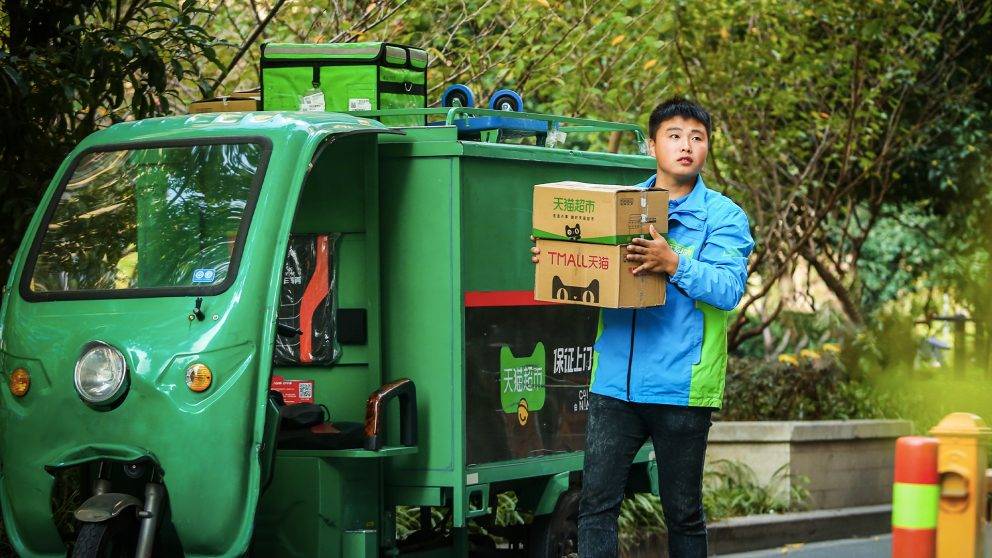
Alibaba Group’s third-quarter profits beat Wall Street’s forecasts by honing its operations against a challenging backdrop created by the coronavirus pandemic and fierce competition.
When China ended its zero-COVID policy late last year, a surge of coronavirus cases disrupted consumption and order fulfillment across the world’s second-largest economy.
“We delivered a solid quarter despite softer demand, supply chain and logistics disruptions due to [the] impact of changes in COVID-19 measures,” said Alibaba’s Chairman and Chief Executive Officer, Daniel Zhang in a statement.
Alibaba’s adjusted EBITA, a non-GAAP measurement, rose 16% year-over-year to RMB52.05 billion ($7.55 billion) in the quarter that ended Dec. 31, beating predictions compiled by Thomson of about RMB47 billion. The platform company has topped quarterly profit forecasts consistently for the past year largely by controlling costs, said sector analysts.
Losses narrowed at Alibaba’s businesses ranging from value-for-money platform Taobao Deals, high-tech supermarket Freshippo, Taocaicai, Turkey’s Trendyol to Southeast Asian e-commerce platform Lazada.
Non-GAAP diluted earnings per American Depository Shares (ADS) for the quarter jumped 14% year-over-year to RMB19.26, topping estimates of roughly RMB16.26 and about RMB16.57 by Thomson and Bloomberg respectively.
“During the past quarter, we continued to improve operating efficiency and cost optimization that resulted in robust profit growth,” said Alibaba’s Chief Financial Officer Toby Xu.
Looking ahead, we expect [a] continued recovery in consumer sentiment and economic activity
Recovery Ahead
Since the start of 2023, stock analysts have been factoring into their forecasts a recovery in consumption across China and a more favorable regulatory environment for the platform company. China reopened its borders on Jan. 8 and has said it would prioritize stimulating consumption.
“Looking ahead, we expect [a] continued recovery in consumer sentiment and economic activity,” said Alibaba’s Zhang.
The International Monetary Fund revised its 2023 forecast for China’s growth sharply higher in January to 5.2% as the economy reopened.
“[The] recovery story is intact for remainder of year,” said Jefferies analysts, including Thomas Chong, in a report to investors after Alibaba’s results.
COVID Surge
China’s retail sector grappled with spikes in COVID-19 cases last year that prompted rolling lockdowns, supply-chain bottlenecks and dampened consumer sentiment, said sector analysts.
China’s total retail sales of social consumer goods in 2022 dipped 0.2% year-on-year, according to the country’s National Bureau of Statistics. Still, online retail sales managed to gain 4% from the previous year. China’s e-commerce industry is already the world’s largest and contributes about 30% of domestic China retail sales, said stock analysts.
Against this backdrop, Alibaba’s quarterly revenue edged 2% higher year-over-year to RMB247.76 billion, just ahead of analysts’ forecasts. China commerce retail business’s quarterly customer management revenue (CMR), mainly marketing services and commissions, dropped 9% year-over-year.
“The gap between paid GMV and CMR is narrowing” as logistics normalize and order returns drop, Alibaba's Xu told analysts.
Online physical goods gross merchandise value (GMV) generated on Chinese digital marketplaces Taobao and Tmall, excluding unpaid orders, dropped by a “mid-single-digit” in the quarter year-over-year. This dip was mainly due to soft consumption and ongoing competition, as well as a surge in COVID-19 cases that resulted in supply chain and logistics disruption in December.
China's largest e-commerce company said the declining GMV growth was driven by weakening demand in the fashion & accessories category, partially offset by accelerating growth for healthcare, pet care and fresh produce, as well as a narrowing decline for the consumer electronics category.
On market competition, Alibaba’s Zhang said price subsidies were nothing new and ineffective in the long run.
“No player ever has managed to achieve that kind of turnaround by relying on price subsidies. What it takes is technology innovation,” Zhang told analysts.
Zhang said Alibaba is working on integrating emerging technologies such generative AI deeply into the business.

Delivering Growth
Alibaba’s logistics arm Cainiao recorded a 27% jump in quarterly revenue after inter-segment elimination year-over-year to RMB16.55 billion, bolstered by a rise in domestic consumer logistics services’ revenue and international fulfillment solution services.
"Everything is now quickly getting back on track. In general, consumer confidence and business confidence are rising. Logistics has resumed normal operations, with the entire supply and manufacturing chains becoming active," said Alibaba's Zhang on a call with analysts.
Alibaba’s Cloud segment, comprising Alibaba Cloud and communications platform DingTalk, recorded a rise of 3% in quarterly revenue after inter-segment elimination year-over-year to RMB20.18 billion. The gain was mainly driven by healthy public cloud growth as the segment continued to drive high-quality, recurring revenue growth, and partially offset by declining hybrid cloud revenue.
“We see the development of this industry, not only China but worldwide, as an absolutely historic opportunity,” Alibaba’s Zhang told analysts.
Alibaba’s international commerce retail businesses Lazada, AliExpress, Trendyol and Daraz’s quarterly combined orders grew 3% year-over-year, primarily driven by the robust order growth of Trendyol.
Among other businesses, both Taobao Deals and Taocaicai narrowed losses during the quarter year-over-year by optimizing user acquisition and improving overall operating efficiency, respectively.
Freshippo delivered double-digit same-store sales growth, recorded a higher gross margin and significantly shrank losses year over year in the quarter.
Benefitting from surging demand for medical and healthcare products due to the surge in COVID-19 cases in December, Alibaba Health achieved rapid year-over-year revenue growth during the quarter.
Alibaba’s local consumer services order volume was flat in the quarter year-over-year. The segment’s losses continued to narrow, driven by Ele.me’s improving operational efficiency.
“Ele.me has been a great success because you need to be able to integrate in real-time local supply, local demand and local fulfilment…in a way that achieves chemical synergies – that’s far beyond the capabilities of any media-oriented player,” said Zhang.
In January, as COVID-19 cases stabilized and travel demand improved, Amap saw demand recover.
“Alibaba has opened up a whole new paradigm on the “to destination” front with the important and successful transformation of Amap,” said Alibaba's Zhang.
Amap has achieved very high penetration in a range of use cases from hotel reservations to finding electric charging facilities for electric vehicles, he added.
Alibaba's travel service Fliggy saw outbound travel snowball as China lifted pandemic-related restrictions.
"[The] recovery of Fliggy’s domestic airplane ticket and hotel bookings was significantly faster than the overall domestic travel performance," said Alibaba's Zhang.
Additional reporting by Elizabeth Utley




